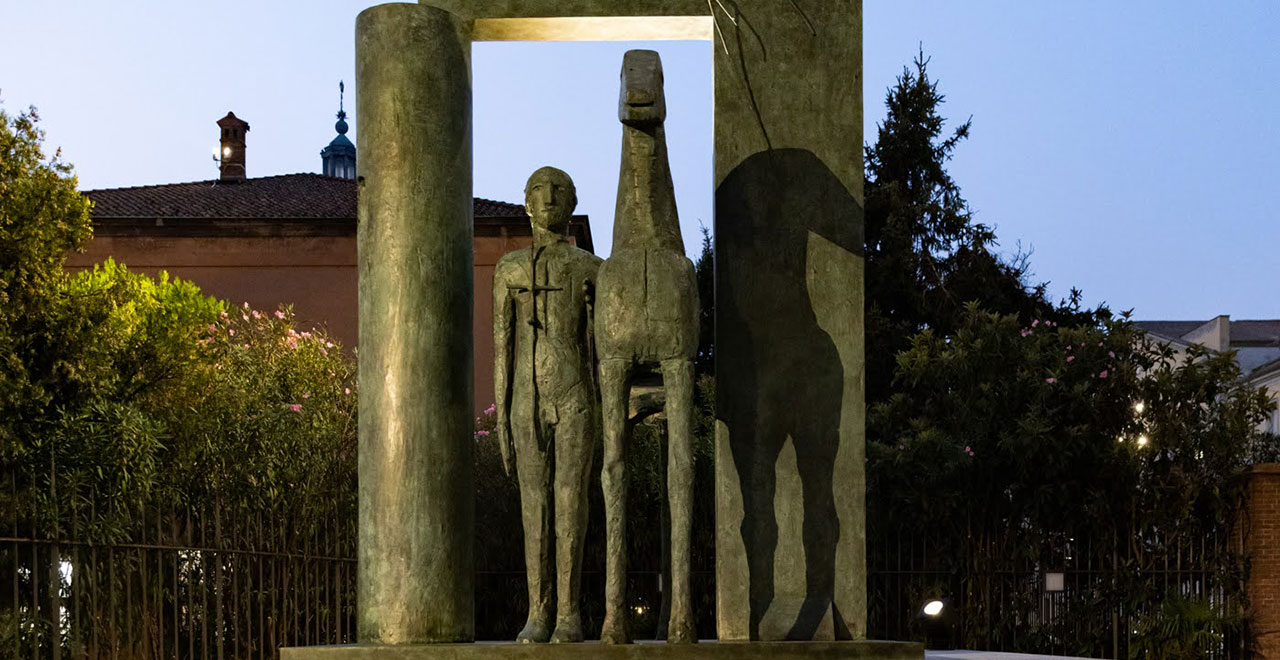
News | Milano
Una scultura di Mimmo Paladino dedicata a Sant’Ambrogio in Cattolica
Mercoledì 11 ottobre nel Cortile d’Onore dell’Ateneo l’inaugurazione dell’opera dell’artista realizzata per il centenario dell’Ateneo
| Redazione
13 ottobre 2023
Condividi su:

A sculpture dedicated to Saint Ambrose and created for Università Cattolica by Mimmo Paladino, an undisputed master of contemporary art. The work, installed in the Cortile d'Onore of the Ateneo, was previewed to the city at Milan with its unveiling on Wednesday 11 October at an evening event. After the Rector Franco Anelli's greeting , the artist, in dialogue with Davide Rampello, a leading figure on the Italian cultural scene, spoke about the inspiration and profound meaning of the sculpture conceived and created for the University of Largo Gemelli.
"The work follows in the footsteps of an ancient tradition of this University, whose iconographic equipment, from the earliest commissions, has aimed to make clear the references, values and intentions that inspired the foundation and development of the University's factory. Mimmo Paladino's monument to Sant'Ambrogio follows this ancient track by rereading the historical, artistic, and religious stratifications of the place, which have been active since the early Christian era," said Rector Anelli, explaining the spirit of the commission that was created on the occasion of the centenary of Università Cattolica. "It was with great joy that I accepted the invitation to create a work for the University. Also, I really liked this idea of commissioning, which is not very common," Paladino said in response to Rampello's questions. A short and intense dialogue, preceded by the projection of a video describing the stages in the realisation of the sculpture: from the Brustolin foundry in Verona, where the work came to life, to its placement in the Cortile d'Onore, placed in an ideal dialogue with the Basilica, which houses the relics of Saint Ambrose, and the facade of the Ateneo by Giovanni Muzio.
Two historical places with which the artist was deeply confronted in the creation of the work. "I had to deal with two very important architectural situations: on the one hand, the Basilica of Sant'Ambrogio, and on the other, an ancient and prestigious University where instinct, passion and reason are forged. Reason also expressed in all its functionality in the 'plinth', which is part of the work and was built taking into account not only the 'surrounding architecture' but also the presence of the students, who experience this place on a daily basis: I wanted to offer them the opportunity to pause, to converse pleasantly, to find their 'little agora' there".
A sculpture that is both 'landscape' and 'theatre', reiterated Rampello. "The work is designed for long distances, for viewers from today to perhaps a hundred years and more," said Paladino. "It is a tribute to Saint Ambrose, hero of knowledge. There are no iconographic references to the Saint as he is traditionally depicted. I preferred to go further, to imagine something more, like Don Quixote who saw warriors in the windmills."
The sculpture, made of patinated bronze, has a base size of 220 cm x 180 cm and a height of 370 cm for a weight of 1,680 kg. Mimmo Paladino's work in all its iconographic attributes traces the salient features of the life of Milan's patron saint. The branch symbolises the pastoral staff, but also recalls the stirrup representing the form, vehemence and depth of the homilies he preached to the people. The book is reminiscent of Ambrose's writings: the epistolary, treatises and hymns and is a symbol of Christian doctrine. The dove of the Holy Spirit evokes Saint Ambrose on horseback chasing away the Aryans. The sphere represents the completeness of the Doctrine. The column, on the other hand, refers to the legend of the fight between the saint and the devil who, trying to hit the bishop with his horns, ended up driving them into the stone, creating two holes. Popular tradition has it that the two holes smell of sulphur and that leaning your ear against the column you can hear the sounds of hell, in particular the gurgling of the Styx, one of the five rivers of the underworld according to Greek and Roman mythology. And finally, the helmet recalls how, in the early Middle Ages, the Basilica of Sant'Ambrogio became the traditional seat where the coronation of the Holy Roman Emperors as kings of Italy took place and where the investiture of new knights, called for this reason 'militia of Sant'Ambrogio', took place.
The work is placed on a series of inclined planes of local grey stone (beola), in the centre of two orthogonal axes and on a base with a height of 140 cm, placed in front of the side facade of the Sacred Heart Chapel. Slight floor slopes and small heights allow visitors to pause and sit along the entire space to observe the sculpture, but also to view the surrounding monuments along new perspectives.
Particular attention is paid to the lighting, which the artist himself has taken care of in detail: the sculpture is enhanced with an almost frontal light and backlighting from below, while the inclined planes have a linear grazing light to highlight the material of the stone.
Paladino's homage to Saint Ambrose is also full of references to the artist's Norman and Lombard origins: the dove that can be seen as a falcon or the references to Frederick II. The same iconic portal is inspired by two other works previously created by the artist: the Gate of Lampedusa and the Gate of Hospitality in the Refectory in Milan. "There is this sort of primitive idea of the house, the dolmen, a lintel with two vertical elements, which is also a threshold that you cross." A sort of threshold-access to another dimension in which, as Rampello suggested, one glimpses 'mystery', 'tension towards the sacred'. "The concept of the door is that of crossing over, of going beyond the unknown," Paladino explained.
Moreover, said Rector Anelli, "for the idea of knowledge that our University cultivates, there is no easy way forward: it is rather a vanishing point towards which reason and intuition, science and spirituality, theory and praxis, history and the future tend. It stems from a multidisciplinary, polyphonic and dialogical vision of knowledge, a vision that the artistic expression, with its immediacy and synthetic capacity, is able to activate, generating the Platonic 'spark' that leads to an accomplished intelligence of things. In this sign, we renew today that ancient pact between art and knowledge that presided over the birth of the University, adding Mimmo Paladino's Saint Ambrose to its repertoire of figures: like the beloved Don Quixote, he shares with the other 'heroes of knowledge', whom the artist has frequented, the ability to go beyond the surface and 'see things that others do not see'. And to point them out to us".
In this sense, "Paladino's work is a powerful, strong sign, situated in a place that is itself dense and full of historical signs," said Bishop Monsignor Claudio Giuliodori, general ecclesiastical assistant of Università Cattolica, during the presentation of the sculpture to the University community at the Athenæum, on Thursday 12 October. After all, "the artist is the one who projects perceptions of reality through signs, traverses time, links history to the past, present and future." And, "looking at this work, the first artistic sensation is that Paladino has given us back a living Ambrose, present in our midst, a presence that impregnates and moulds these places with meaning, giving them a further dynamism." A kind of lighthouse that induces one to look towards Saint Ambrose, while letting oneself be guided by the "inspiration of our founders". Therefore, "a precious heritage that gives us back a bit of history and makes us look open to the future challenges of freedom, truth and charity".
Un articolo di
